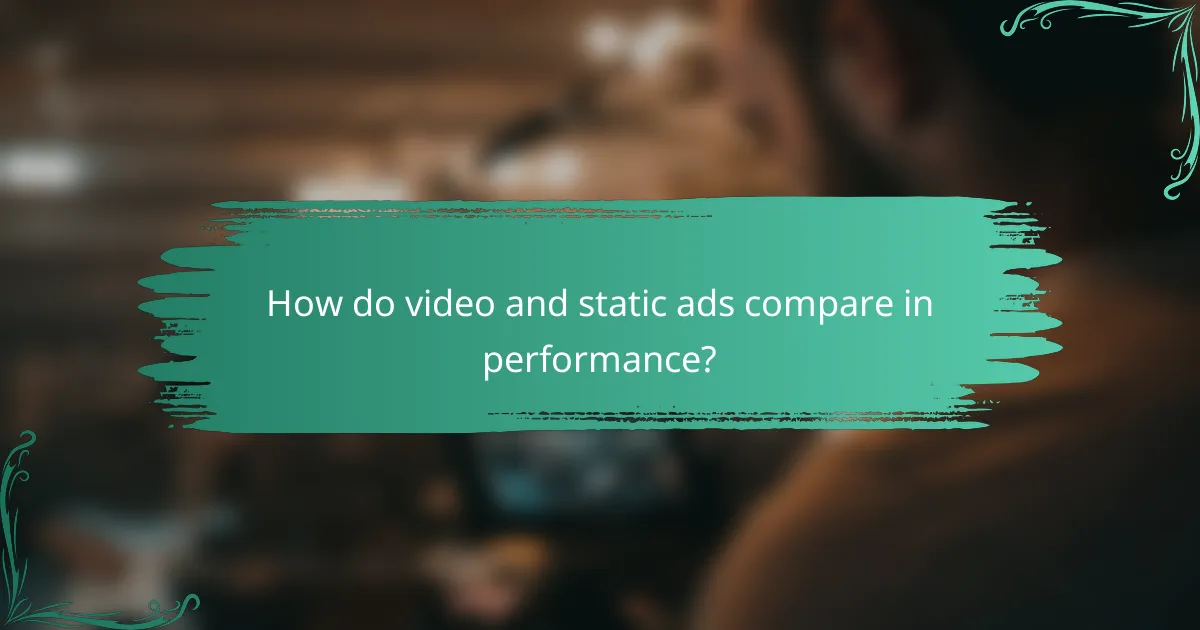When deciding between video and static display ads, it’s essential to consider your campaign goals and target audience. Video ads excel in engagement and message retention, leveraging both visual and auditory elements to create a memorable experience. In contrast, static ads provide a cost-effective solution for straightforward messaging and brand awareness, making them suitable for simpler campaigns. Understanding the strengths of each format will help you choose the right approach for your advertising needs.

What are the advantages of video display ads?
Video display ads offer several advantages over static ads, primarily in their ability to engage viewers and convey messages more effectively. They combine visual and auditory elements, making them more dynamic and memorable.
Higher engagement rates
Video display ads generally achieve higher engagement rates compared to static ads. This is due to their ability to capture attention quickly through movement and sound, encouraging viewers to interact with the content. Many studies suggest that video ads can increase click-through rates significantly, often exceeding those of traditional formats.
Better storytelling capabilities
Video display ads excel in storytelling, allowing brands to convey complex messages through narrative and visuals. This format enables advertisers to build a storyline that resonates with the audience, making it easier to communicate brand values and product benefits. For instance, a short video can illustrate a product’s use in real-life scenarios, enhancing relatability.
Increased brand recall
Viewers are more likely to remember brands that use video display ads due to the multisensory experience they provide. Engaging visuals and sound create a stronger impression, leading to improved brand recall. Research indicates that consumers can recall video ads better than static ones, often remembering key messages long after viewing.
Enhanced emotional connection
Video display ads can evoke emotions more effectively than static ads, fostering a deeper connection with the audience. By using storytelling, music, and visuals, brands can create emotional narratives that resonate with viewers, prompting them to feel empathy or excitement. This emotional engagement can significantly influence purchasing decisions.
Improved conversion rates
Video display ads often lead to higher conversion rates, as they can effectively guide viewers through the customer journey. By showcasing products in action or providing testimonials, these ads can address potential objections and encourage immediate action. Many marketers find that incorporating video into their campaigns can boost conversions by a notable percentage, making it a valuable tool for driving sales.

When should you use static display ads?
Static display ads are ideal when you need a straightforward, cost-effective advertising solution. They work well for campaigns focused on brand awareness or delivering simple messages without the need for complex animations or video content.
Cost-effective for budget constraints
Static display ads typically require lower production costs compared to video ads, making them a smart choice for businesses with tight budgets. They can be created using basic graphic design tools, allowing even small companies to invest in advertising without overspending.
For example, a small business might allocate a few hundred USD for a series of static ads, while video production could easily run into thousands. This cost efficiency enables more frequent ad placements, increasing overall visibility.
Faster loading times
Static display ads generally load much faster than video ads, which is crucial for maintaining user engagement. Faster loading times can lead to lower bounce rates and improved user experience, especially on mobile devices where connectivity may vary.
In practice, static ads can load in low tens of milliseconds, while video ads may take several seconds, depending on the user’s internet speed. This speed advantage makes static ads preferable for audiences with limited bandwidth.
Effective for brand awareness
Static display ads are effective for building brand awareness as they can be easily designed to highlight logos, colors, and key messages. Consistent use of branding elements across multiple static ads helps reinforce brand identity in the minds of consumers.
For instance, a company might run a series of static ads featuring its logo and slogan across various websites, ensuring that potential customers recognize the brand when they encounter it again in different contexts.
Suitable for simple messaging
Static display ads excel at conveying straightforward messages quickly and clearly. They are perfect for promotions, announcements, or calls to action that do not require elaborate storytelling or visual effects.
For example, a seasonal sale can be effectively communicated through a simple static ad with bold text and an eye-catching image, prompting viewers to take immediate action without the distraction of complex animations. This clarity is essential for effective advertising, especially in crowded digital spaces.

How do video and static ads compare in performance?
Video ads generally outperform static ads in engagement and retention, but the effectiveness can depend on the campaign goals and target audience. While video can capture attention more effectively, static ads may be more cost-efficient for straightforward messaging.
Click-through rates analysis
Click-through rates (CTR) for video ads tend to be higher than those for static ads, often exceeding 1% in many industries. This increased engagement is attributed to the dynamic nature of video content, which can convey messages more compellingly than static images.
However, the effectiveness of static ads shouldn’t be underestimated. In specific contexts, such as retargeting campaigns, static ads can achieve comparable CTRs, especially when they feature strong calls to action and visually appealing designs.
Conversion metrics comparison
Conversion rates for video ads can be significantly higher, sometimes reaching double digits, as they often provide a more immersive experience. This can be particularly effective for products that require demonstration or storytelling to persuade potential customers.
Static ads, while generally lower in conversion rates, can still be effective for direct-response campaigns, especially when targeting specific demographics. A/B testing different formats can help determine which approach yields better conversions for your specific audience.
Audience retention statistics
Video ads typically have better audience retention, with many viewers watching at least 80% of a short video. This retention is crucial for brand recall and can lead to higher engagement over time.
In contrast, static ads may only capture attention for a brief moment, making it essential to design them to quickly convey key messages. Ensuring that static ads are visually striking can help improve retention rates, even if they are inherently limited compared to video.
Cost per acquisition differences
The cost per acquisition (CPA) for video ads can be higher due to production and placement costs, often ranging from a few dollars to several tens of dollars, depending on the platform and targeting. However, the potential for higher engagement and conversion can justify this investment.
Static ads usually have a lower CPA, often in the low single digits, making them a more budget-friendly option for campaigns focused on volume. Choosing the right format should align with your overall marketing strategy and budget considerations.

What factors influence the choice between video and static ads?
The choice between video and static ads is influenced by several key factors, including target audience preferences, campaign objectives, budget considerations, and ad placement options. Understanding these elements can help marketers select the most effective ad format for their needs.
Target audience preferences
Knowing your target audience is crucial when deciding between video and static ads. Younger demographics often prefer engaging video content, while older audiences may respond better to straightforward static images. Conducting surveys or analyzing past campaign performance can provide insights into what resonates with your specific audience.
Additionally, consider the platforms your audience frequents. For instance, social media platforms like Instagram and TikTok favor video content, while traditional websites may still attract users with static ads.
Campaign objectives
Your campaign goals significantly impact the choice of ad format. If the aim is to build brand awareness or tell a story, video ads can be more effective due to their ability to convey emotion and detail. Conversely, if the goal is to drive immediate conversions, static ads may be more suitable for their simplicity and direct call-to-action.
Evaluate the desired outcome of your campaign. For example, a product launch may benefit from a video showcasing features, while a seasonal sale might work well with a static ad highlighting discounts.
Budget considerations
Budget plays a vital role in determining whether to use video or static ads. Video production can be more expensive due to the need for scripting, filming, and editing, often costing hundreds to thousands of dollars. Static ads, on the other hand, generally require less investment, making them a more budget-friendly option.
However, consider the potential return on investment. If video ads can significantly boost engagement and conversions, the higher upfront cost may be justified. Always weigh the costs against the expected benefits to make an informed decision.
Ad placement options
The platforms where you plan to place your ads can influence the choice between video and static formats. Video ads are often more suitable for platforms like YouTube and social media, where users expect dynamic content. Static ads, however, are effective on websites, newsletters, and search engines where quick visuals are needed.
Consider the specifications and limitations of each platform. For example, some social media sites may have restrictions on video length, while others may prioritize video ads in their algorithms, affecting visibility and engagement rates.

What are the best practices for using video display ads?
To effectively use video display ads, focus on engaging content, clear messaging, and strategic placement. These elements help capture audience attention and drive conversions.
Optimal video length
The optimal length for video display ads typically ranges from 15 to 30 seconds. This duration is long enough to convey a message while being short enough to maintain viewer interest.
Consider the platform when determining video length. For example, social media platforms often favor shorter videos, while websites may allow for slightly longer formats. Always prioritize delivering your key message early to avoid losing viewers.
Avoid overly long videos, as they can lead to viewer drop-off. Aim for concise storytelling that highlights the main points quickly and effectively.
